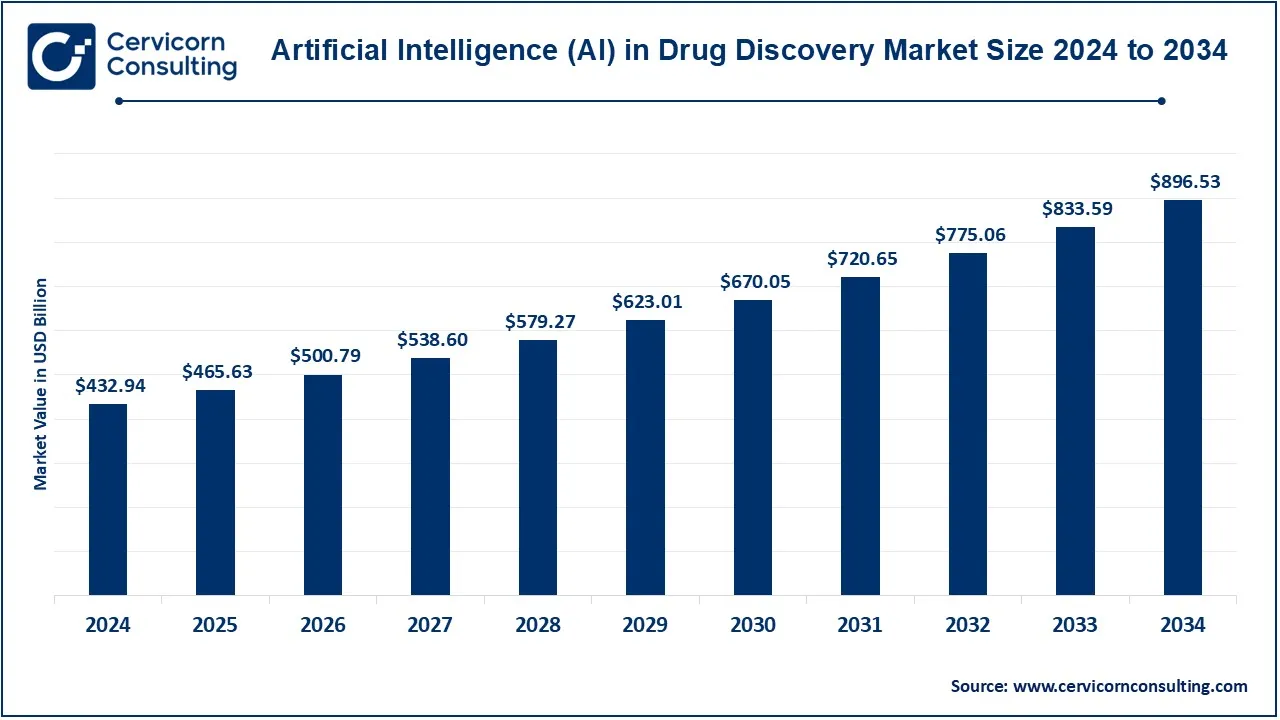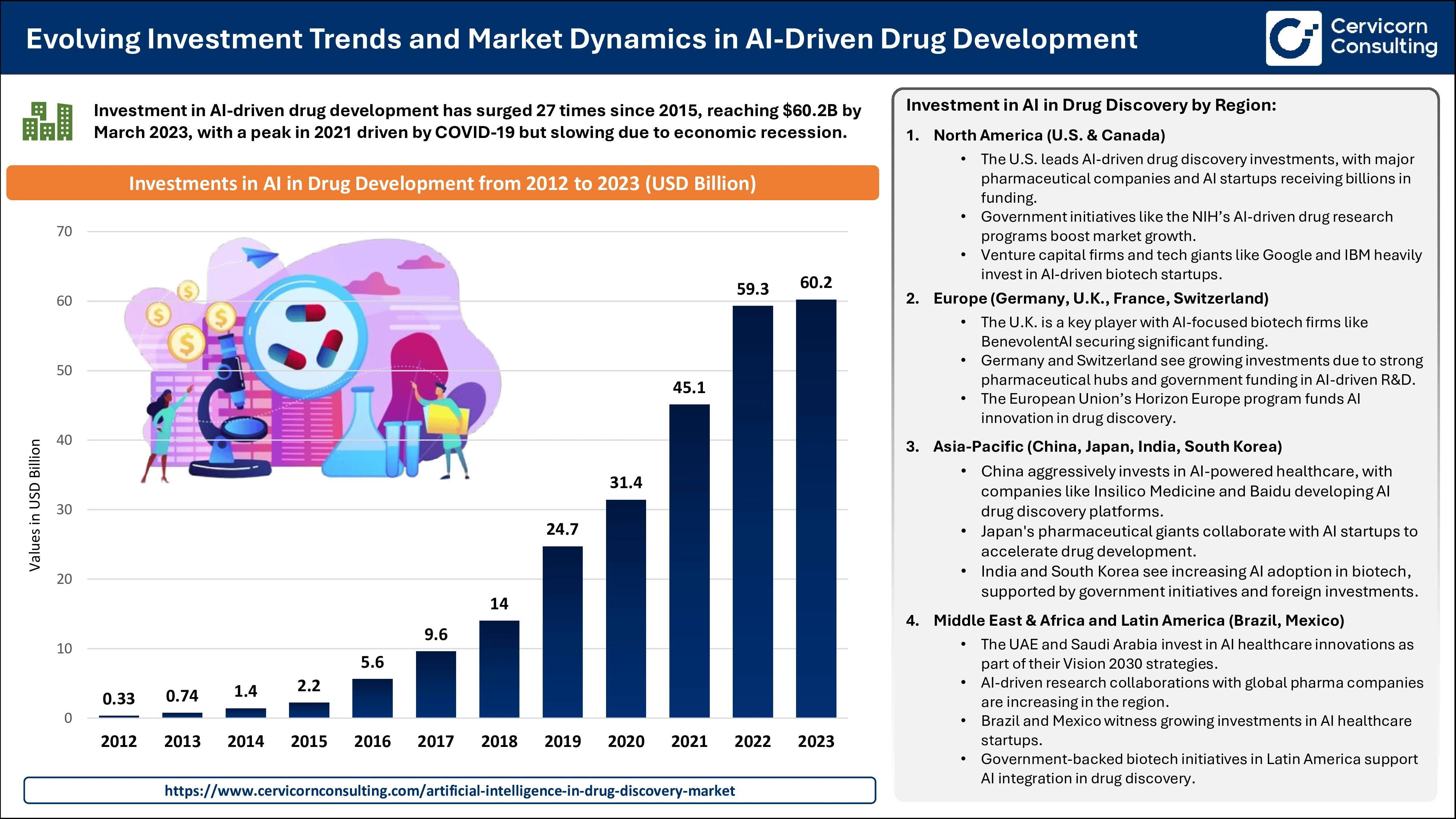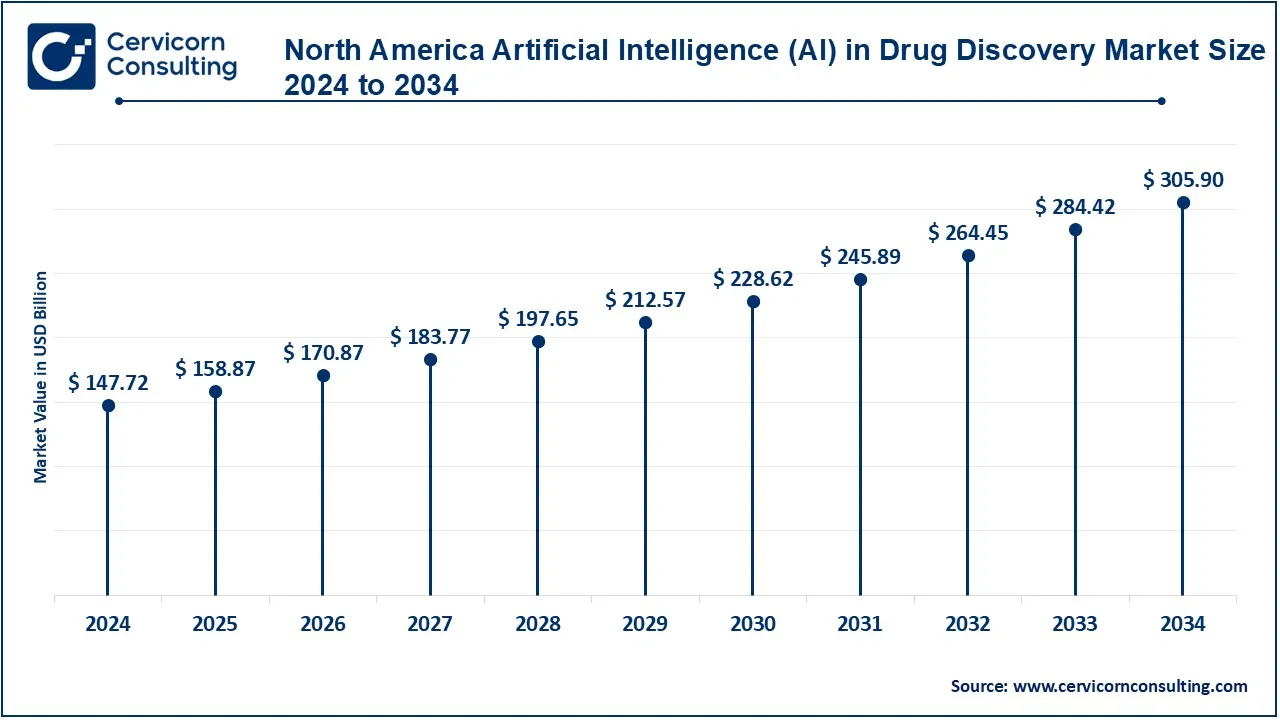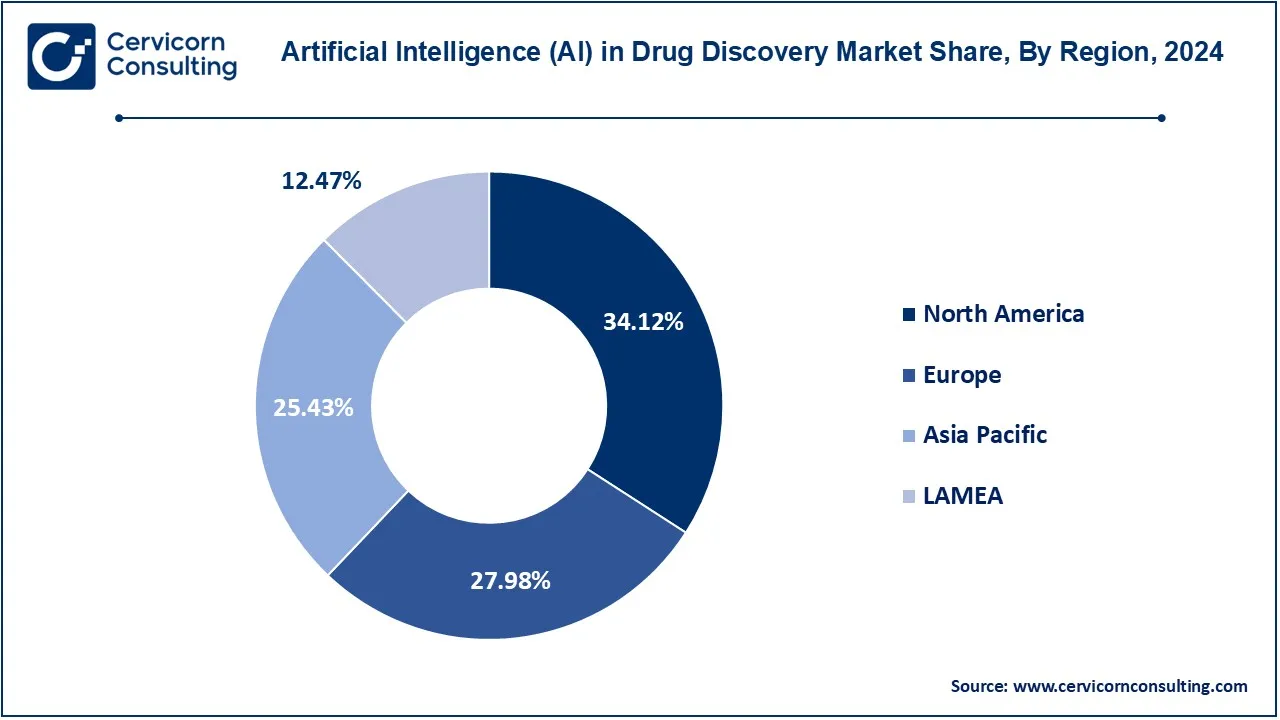Artificial Intelligence (AI) In Drug Discovery Market Size and Growth 2025 to 2034
The global artificial intelligence (AI) in drug discovery market size was reached at USD 1.98 billion in 2024 and is expected to surpass around USD 20.31 billion by 2034, exhibiting at a compound annual growth rate (CAGR) of 26.21% over the forecast period 2025 to 2034.
There has been a significant growth in the artificial intelligence (AI) in drug discovery market. The increase in AI technology usage to achieve greater efficiencies and be faster in the process of drug development drives investment in AI-powered solutions by companies for target identification, optimizing a discovery of molecules and prediction of clinical trials outcomes, all to help accelerate the process and reduce time and costs normally incurred with traditional methods. Inclusion of machine learning, deep learning as well as natural language processing allows analyses of enormous datasets and discovers insights impossible otherwise.

Among the market boosting factors are an increased investment in biotechnology and pharmaceutical research and development, demand for precision medicine. Collaborations between technology companies and drug developers also increase hype and awareness in the market, with mentioned factors affecting the market in emerging economies. Although the industry suffers numerous challenges, including regulatory bottlenecks and data privacy concerns, they are expected to break through with advances in AI algorithms and also improvements in the power of computers, thus propelling the market further into transforming methods of drug discovery, thereby bringing innovations in the healthcare sector.

Guadalupe Hayes-Mota: CEO and Founder of Healr Solutions
“The biopharmaceutical industry stands on the cusp of a revolution, with artificial intelligence (AI) emerging as a transformative force in drug development. AI's ability to reduce the time and cost of bringing new drugs to market is not just a promise; it is becoming a reality.”
Report Highlights
- The U.S. AI in drug discovery market was valued at USD 0.86 billion in 2024.
- TheNorth America has acoounted for highest revenue share of 57.60% in 2024.
- The Europe has generated revenue share of 21.40% in 2024.
- By therapeutic area, the oncology segment has recorded revenue share of 22.50% in 2024.
- By application, the drug optimization and repurposing segment has captured revenue share of 53.40% in 2024.
- By end user, the pharmaceutical and biotechnology companies segment has held revenue share of 61.70% in 2024.
Artificial Intelligence In Drug Discovery Market Growth Factors
- Increasing Pharmaceutical R&D Spending: The pharmaceutical companies are investing in the R&D to cater the rising demand for the innovative medicines. The AI helps in the R&D process by boosting the drug discovery, reducing costs along with optimizing resource allocation. The traditional drug development generally includes high rate of failure along with long timelines and huge costs and AI is equipped with the predictive analytics and data-driven insights to reduce such issues.
- Demand for Precision Medicine: The precision medicine that provides personalized treatment based on an individual's genetic profile will be one of the major demand engines that will drive those using AI in drug discovery. AI technologies examine vast amounts of data, such as genome and proteome data, to find out the disease markers and mechanisms by which the disease develops at a molecular level. The result will be well-targeted and effective treatments with fewer side effects. As more and more "personalization" becomes the focus of modern medicine, AI is increasingly being adopted in the drug discovery process to discover patient-specific solutions in finding their applications in trialing.
- Use of Big Data: Huge amounts of data are produced daily in the health sector by the enormous genomic sequences, clinical trials, and electronic health records. However, processing and extracting meaning from data tend to be a daunting exercise to accomplish. While AI specializes in handling and analyzing complex and unstructured data, researchers can now understand patterns and important correlations which seemed otherwise impossible. Thus, big data will make AI feasible in improving drug target identification, speeding hypothesis testing, and, mostly, in making intelligent decisions at every stage of the drug discovery process.
- Advancements in AI Technologies: The rapid developments of AI technologies like machine learning, deep learning, and natural language processing had enhanced the capabilities of the AI in the drug discovery. Such technologies enable the predictive modeling, virtual screening of compounds and identification of the novel therapeutic targets having the high accuracy and efficiency. AI algorithms have become fully sophisticated, rendering them capable of processing myriads of datasets and extracting complex and pleomorphic relationships among variables. These new dimensions have made AI tools critical for any pharmaceutical concern desiring to bolster the productivity and efficacy of its R&D pipelines, thus boosting the market in AI in drug discovery.
- Reduced Time for Drug Development: It can speed part of the entire drug discovery process from target identification to lead optimization and designing clinical trials. Conventional drug development processes normally span over a decade; incurs significant costs; and almost always come with the element of risk of failure. AI shortens such timelines by rapidly analyzing datasets, predicting effectiveness of compounds, and identifying potential safety issues at earlier stages of the pipeline. It reduces the time spent in developing drugs and the resources needed to bring one into the market much faster.
Artificial Intelligence In Drug Discovery Market Trends
- Collaboration between Pharma and Tech Companies: The collaboration between the pharma and technology companies which are specialized in the AI innovation for propelling the therapeutic discovery. Such alliances increases the domain knowledge of pharma companies as well as the capabilities of the AI companies for the manufacturing of advanced solutions. For instance, joint ventures within pharmaceutical houses with respect to AI integrations in drug pipelines would play a role in energizing efficiencies, new target identifications, and enhanced clinical trial outcomes. Such partnerships will be an exciting opportunity for innovation and quick advances in application development in AI; thus, the major growth engine for this market.
- Increase in Chronic Diseases: There has been a surge in the prevalence of the chronic diseases like cancer, diabetes, and cardiovascular diseases which leads to the production of the innovative drugs. The capability of AI in assessing the pathways concerning complex diseases, identification of drug targets, and predict the treatment outcomes is important for addressing the demand. It is, however, very critical in fast-tracking the discovery of effective therapeutics, hence making the most impact in battling these challenges as a whole. The application of AI to understanding mechanisms of diseases and thus customizing treatments is one of the important factors driving growth in an AI in drug discovery market.
- Supportive Regulatory: More and more regulatory bodies such as the FDA and EMA are encouraging the potential of AI to dramatically change drug discovery while offering guidelines, frameworks, and other facilitative measures toward a more comprehensive adaptation of AI applications in drug development; regulatory support addresses parts of data privacy, algorithmic transparency, and ethical issues. This proves very important encouragement from regulatory authorities to promote belief and quicken the ramp-up of adopting AI technologies into the pharmaceuticals industry, thereby inducing growth in the marketplace.
- Cost-Efficiency in Drug Development: New avenues particularly opened by AI that are able to save costs related to streamlining processes, relieving influential downloadable trials, and ultimately optimizing resource utilization will be extended. Traditional drug development involves a high risk for finance and extremely time-consuming and rather unpredictable. But AI brings within its confines the risk reduction which it does by improving decision-making capabilities and redundancy pruning. Bringing down costs of development further enables small biotech companies and start-ups to penetrate the industry, bearing in mind the growth it is enjoying further.
- Availability of Cloud Computing: The availability of cloud computing-enabled revolutionizes AI's applications at drug discovery. Most researchers utilize cloud platforms since it makes available computation and storage resources necessary to run sophisticated AI algorithms for large datasets with efficiency. With this, both the large and the small organizations could economically incorporate the benefits of AI, all without the stark investments that would ordinarily be expensive in infrastructure. Therefore, as AI tools with cloud computing further narrow down into collaboration processes and research, it is indeed a major enabler of growth for the AI drug discovery market.
Report Scope
| Area of Focus |
Details |
| Market Size in 2024 |
USD 1.98 Billion |
| Projected Market Size in 2034 |
USD 20.31 Billion |
| Expected CAGR 2025 to 2034 |
26.21% |
| Dominant Region |
North America |
| High Growth Region |
Asia Pacific |
| Key Segments |
Therapeutic Area, Application, Offering, Technology, Use Case, Deployment, Process, Player Type, End Use, Region |
| Key Companies |
IBM, Atomwise Inc., BenevolentAI, Berg Health, BioSymetrics, Inc., BPGbio Inc., CYCLICA, Exscientia, GNS Healthcare, Google, Insilico Medicine, insitro |
Artificial Intelligence In Drug Discovery Market Dynamics
Drivers
Integration of Genomics and AI
- The ability of AI to process and analyze the genomic data is changing the process of the drug discovery. Identification of the genetic variants and linking them to diseases aids in the discovery of new drug targets and biomarkers. Such genomics and AI combinations offer a new avenue for innovation in pharmaceutical industry which is expected to boost the growth of the market.
Increasing Government and Private Funding
- Funding for drug discoveries through AI by the government and private funders is huge because they constantly realize that AI has its transformative potential for drug discoveries. These uses are used for advanced applications of AI and, thus, incorporation into pipelines for drugs. Funding even goes beyond collaborations between academia, biotech start-ups, and pharmaceutical companies for making faster strides in the field.
Restraints
High Implementation Costs
- Integration of AI technologies into drug discovery processes requires high investment in infrastructure, software, and skilled professionals. High-level AI tools often demand much computational power or equipment specialized storage capabilities, making even start-ups and smaller organizations cost-prohibitive and adding to the cost of training towards effective use of AI. All these heavy costs in implementation restrict the adoption of AI technologies in developing countries, thus becoming an imperative restraint to market growth.
Data Privacy and Security Concern
- The integration of the AI in drug discovery involves handling the sensitive and large data, involving patient records along with genomic data and proprietary research. Ensuring the privacy and security of such data can be a major challenge. The breach or misuse of the data can cause ethical, legal, and reputational issue holding back the organizations from adopting AI technologies. At the same time, regulatory frameworks - such as GDPR and HIPAA - have the phenomenon of strict data protection mandates put on data, highlighting the extra burden incurred for depth and complication in compliance, further but not limited to being a deterrent to market penetration.
Opportunities
Increased Adoption of AI in Drug Design
- AI is now penetrating the early stages of drug discovery and preclinical studies-the hit identification stage-and it promises to revolutionize the whole process much more effectively. It allows creation of compounds and predicts key bio-on characteristics, so there is minimal time loss in performing trial and error and much smoother running of pipelines, thereby increasing the chances thereby making it critical for future growth drivers.
Emerging Technological Innovations in Biomarker Discovery
- AI has become a third party in developing important drug markers for the precision therapy concept: AI engages in diagnostic biomarker discovery through the study of biological data to yield potential candidates in predicting disease progress, drug response, and patient outcome; thereby increasing treatment accuracy and effectiveness and hence producing a favourable environment for growth of AI in drug development.
Challenges
Regulatory and Ethical Challenges
- There are no clear and consistent regulatory guidelines about AI usage in drug discovery. So, it detains uncertainties for the companies. Regulators are still adjusting themselves to the rapid forward movement of AI technology, which causes delays in the approval process and also inconsistencies in the standards from different regions. Furthermore, ethical problems such as algorithmic bias and transparency issues will also add to the complexity of introducing AI in drug development processes. These would hamper innovation and the eventual openness of AI across the pharmaceutical world.
Limited Access to Quality Data
- Available AI-algorithms require enough amounts of high-quality data normalized standards; however, this is rare in the pharmaceutical industry as data are mostly fragmented, inconsistent, or even siloed across organizations. The absence of interoperability among databases and the difficulty of acquiring curated datasets create a barrier to the full floors for AI models. The lower availability of data results in inaccuracy and unreliability of AI-powered predictions and can severely constrain the application of drug discovery.
Artificial Intelligence In Drug Discovery Market Segmental Analysis
Therapeutic Area Analysis
Oncology: The Oncology segment has dominated the market in 2024. Oncology is one These therapeutic areas where AI has made much contribution to the development of drugs through discovery. AI is used to evaluate enormous pieces of data like genomic profiles and tumour biology, and from that information, develop new targets for the invention of new drugs and precision therapy. Very huge benefits of AI lie on its capability to discover "biomarkers," which used to steer almost any development of targeted treatment like these immunotherapies or personal cancer drugs. Not forgetting, the repurposing of already known medicines to be used differently for cancer types is much faster due to AI, as well as predicting how patients will respond to therapies.
Infectious Diseases: The forms of artificial intelligence that spread across different medical or life discovering areas such as discovery of new drugs in infectious diseases. It would lead to the rapid identification of novel therapeutics that are effective against bacterial, viral or parasitic infections that leave a disease behind. For example, the occurrence of global health crises like COVID-19 has put a greater spotlight on "timeliness," where AI played significant roles in repurposing drugs, developing vaccines, as well as increasing knowledge on pathogen behavior. For example, AI-based algorithms not only analyze pathogen genomes in record time, but also predict drug-resistance patterns and potential candidates for drug discovery.
Metabolic Diseases: Currently, using AI, drug discovery is becoming more advanced by applying it in the areas of metabolic diseases, which include diabetes and obesity, through analysis of complex biological networks, thereby finding novel therapeutic targets. Such diseases are typically managed with key and complex hypothalamic and metabolic pathways as well as peripheral organ functions in hormones, metabolism and organ functions. Normally, biological complexes are difficult to decipher and, therefore, difficult to treat using standard methods. AI tools convert multi-omics data such as genomic, proteomic and metabolomic data and enable discovering novel mechanisms of disease. AI increases efficacy by modelling metabolism interactions and predicts drug effectiveness and accelerates personalized therapies.
Cardiovascular Diseases: Cardiovascular diseases like hypertension, atherosclerosis, or even heart failures, are few of the paramount mortality rates around the world. Artificial Intelligence has brought a revolution in drug discovery methods for these diseases by evaluating large datasets compiled from electronic health records, imaging, and genetic studies, which can help identify additional drug targets and biomarkers for these diseases. Such AI algorithms virtually help simulate the effects of any candidate drug on cardiovascular systems and substitute preclinical experimentation.
Neurodegenerative Diseases: AI is increasingly proving its worth value in drug discoveries for neurodegenerative diseases that are very hard to treat, such as Alzheimer's, Parkinson's, and Huntington's disease. These diseases have pathways in the human brain that are by no means simple, and their understanding at molecular and cellular levels is hard to acquire. AI facilitates the investigations of large datasets of brain imaging with genetic and clinical trial data for new therapeutic targets. AI contributes to drug and clinical trials' design by prediction of disease trajectory and outcome.
Application Analysis
Preclinical Testing: Drug discovery is continuously transformed by the artificial intelligence revolution that improves drug prediction concerning safety, efficacy, and toxicity before clinical trials. Traditional preclinical tests have animal studies that are usually very expensive and time-consuming and have a poor translation into humans. AI models use complex biological data including genomics, proteomics, and chemical properties of inform drugs on biological systems. This would enable the capture of earlier potential issues in the pipeline, minimizing animal models and increasing the success rate of clinical trials.
Artificial Intelligence (AI) In Drug Discovery Market Revenue Share, By Application, 2024 (%)
| Application |
Revenue Share, 2024 (%) |
| Preclinical Testing |
28.80% |
| Drug Optimization and Repurposing |
53.40% |
| Others |
17.80% |
Drug Optimization & Repurposing: AI is an important part of drug optimization and repurposing by identifying potential new therapeutic indications for already existing drugs and improving the drug effect of drug candidates. In fact, an AI would analyze enormous amount of molecular structures, biological targets, and real patient data, to develop new indications for already approved drugs. Hence, it reduces development and costs of traditional drug discovery. More than this, AI even paves way for lead optimization through predicting modifications which enhance efficacy, minimize toxicity, or improve pharmacokinetics.
End User Analysis
Based on end user, the market is segmented into pharmaceutical and biotechnology companies, contract research organization (CROs) and others. The pharmaceutical and biotechnology companies has dominated the market in 2024.
AI in Drug Discovery Market Revenue Share, By End User, 2024 (%)
| End User |
Revenue Share, 2024 (%) |
| Pharmaceutical and biotechnology companies |
61.7% |
| Contract research organization (CROs) |
26.4% |
| Others |
11.90% |
Artificial Intelligence In Drug Discovery Market Regional Analysis
The AI in drug discovery market is segmented into various regions, including North America, Europe, Asia-Pacific, andLAMEA. Here is a brief overview of each region:
Why is North America is leading in the AI in drug discovery market?
The North America AI in drug discovery market size was reached at USD 1.14 billion in 2024 and is expected to reach around USD 11.70 billion by 2034. North America is leading the market owing to the enormous investments in pharmaceutical research, sufficient advanced healthcare infrastructure, and greater use of innovative technologies. Moreover, the region has a number of biotech companies, research institutions, and leading pharmaceutical companies that focus on utilizing AI in drug discovery processes.

Europe AI in Drug Discovery Market Trends
The Europe AI in drug discovery market size was accounted for USD 0.42 billion in 2024 and is projected to hit around USD 4.35 billion by 2034. Europe is propelled by well-built respective pharmaceuticals and biotechnology industries. In addition, the region enjoys large funding from its governments in AI and health research while building collaborations between academic institutions, start-ups, and major pharmaceutical companies. Germany, U.K., and France are top countries absorbing the technologies of AI in drug discovery.
Why is Asia Pacific growing very fast in the AI in drug discovery market?
The Asia Pacific AI in drug discovery market size was estimated at USD 0.28 billion in 2024 and is predicted to reach around USD 2.86 billion by 2034. Asia-Pacific region is growing very fast in the market. The government decides to invest massively in healthcare and technology, China, Japan, and India are few countries on the front lines using AI to simplify drug discovery as they are challenged by rising chronic diseases. Government promotions on fresh initiatives of AI innovation and growing biotechnological industry in the region are some of the key elements powering market growth.

LAMEA AI in Drug Discovery Market Growth
The LAMEA AI in drug discovery market was valued at USD 0.16 billion in 2024 and is anticipated to reach around USD 1.60 billion by 2034. The region known as LAMEA now gradually undergoes actualization of what AI can do in drug discovery as investments in healthcare increase and people learn about the promise of AI. Advancements are being seen in Latin America, especially Brazil, as local universities and international organizations collaborate to achieve biomedical innovation. In the Middle East, the UAE and Saudi Arabia are focusing on channeling investment into AI research as part of wider moves to modernize healthcare.
Artificial Intelligence In Drug Discovery Market Top Companies
- IBM
- Atomwise Inc.
- BenevolentAI
- Berg Health
- BioSymetrics, Inc.
- BPGbio Inc.
- CYCLICA
- Exscientia
- GNS Healthcare
- Google
- Insilico Medicine
- insitro
The new entrants in AI drug discovery leverage new technologies to disrupt the traditional drug development processes. The technology focuses on predictive modelling, drug repurposing, and biomarker discovery. For target identification, lead compound optimization, time, and cost reduction in conventional drug discovery, advanced AI algorithms, machine learning, and big data analytics are used. Most of these incoming firms are opting for strategic partnerships with an already-existing pharmaceutical company so that they could combine clinical and market knowledge with AI expertise. New entrants also try out some innovative business models such as offering an AI platform as a service or collaborating with others on risk-sharing agreements, wherein the rewards would be tied to the success of the drug. Additionally, these players emphasize cloud computing, real-world data integration, and multi-omics analysis, allowing for scalable solutions.
Recent Developments
- In 2024, Exscientia announced an expanded partnership with Amazon Web Services (AWS) to leverage AWS's AI and machine learning (ML) capabilities to improve its comprehensive drug discovery and automation platform.
- In 2024, Google DeepMind launched the third version of its AlphaFold AI-driven model, designed to further advance drug design and disease targeting. This new version enables researchers at DeepMind and Isomorphic Labs to analyze the behavior of all types of molecules, including human DNA.
- In 2024, Xaira Therapeutics, a company focused on AI-driven drug discovery and development, secured over USD 1 Million in a joint funding round alongside ARCH Venture Partners and Foresite Labs. The firm employs machine learning, data generation models, and therapeutic product development to address traditionally difficult drug targets.
Market Segmentation
By Therapeutic Area
- Oncology
- Infectious Disease
- Metabolic Disease
- Cardiovascular Disease
- Neurodegenerative Disease
- Others
By Application
- Preclinical Testing
- Drug Optimization and Repurposing
- Others
By Offering
By Technology
- Machine learning
- Deep learning
- Supervised learning
- Unsupervised learning
- Other
- Natural Language Processing (NLP)
- Computer Vision
- Others
By Use Case
- Drug Repurposing
- De Novo Drug Design
- Small Molecule Design
- Vaccine Design
- Antibody and other Biologics Design
- Drug Optimization
- Small Molecule Optimization
- Vaccine Optimization
- Antibody and other Biologics Optimization
- Safety and Toxicity
By Deployment
- On-premise
- Cloud Based
- SaaS Based
By Process
By Player Type
- End-To-End Solution Providers
- Niche/Point Solution Providers
- Business Process Service Providers
By End Use
- Pharmaceutical and biotechnology companies
- Contract research organization (CROs)
- Other end-users
By Region
- North America
- APAC
- Europe
- LAMEA
...
...



